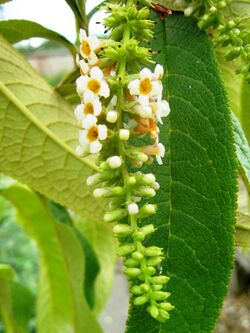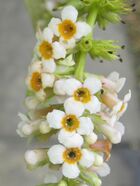Biology:Buddleja forrestii
| Buddleja forrestii | |
|---|---|

| |
| Buddleja forrestii inflorescence | |
| Scientific classification | |
| Kingdom: | Plantae |
| Clade: | Tracheophytes |
| Clade: | Angiosperms |
| Clade: | Eudicots |
| Clade: | Asterids |
| Order: | Lamiales |
| Family: | Scrophulariaceae |
| Genus: | Buddleja |
| Species: | B. forrestii
|
| Binomial name | |
| Buddleja forrestii Diels
| |
| Synonyms | |
| |
Buddleja forrestii is a deciduous shrub or small tree widely distributed from India to western China . First described by Diels in 1912, he named the species for plant hunter George Forrest, who discovered the plant in Yunnan in 1904 and introduced it to Western cultivation.[1][2]
Description
Buddleja forrestii grows to < 6 m in height in the wild. The branches are tetragonous, and bear lanceolate leaves, which are opposite, < 25 cm long; the undersides covered with reddish-brown hairs.[1] The species is chiefly distinguished by its inflorescences, pendulous terminal panicles < 25 cm long comprising virtually scentless flowers which appear in late summer; their colour varies considerably, ranging from pale maroon, through mauve, and blue, to almost white.[2][3] Ploidy 2n = 114 (hexaploid).[4]
Cultivation
Buddleja forrestii is not fully hardy in the UK, and best grown against a south-facing wall, or in pots which can be removed to the greenhouse or conservatory in winter. A specimen is grown as part of the NCCPG national collection at Longstock Park Nursery, near Stockbridge, Hampshire.[5] Hardiness: USDA zones 8–9.[1]
Hybrids and cultivars
- 'Hotblackiana'. 'Hotblackiana' was derived from a rare, possibly unique, crossing of forrestii with B. davidii var. veitchiana by Herbert Hotblack at Deak's Manor, Cuckfield, Sussex, England, and exhibited at the Chelsea Flower Show in 1952. The hybrid is not known to survive.[6][7]
References
- ↑ 1.0 1.1 1.2 Stuart, D. (2006). Buddlejas. RHS Plant Collector Guide. Timber Press, Oregon, USA. ISBN:978-0-88192-688-0
- ↑ 2.0 2.1 Bean, W. J. (1914). Trees and shrubs hardy in the British Isles, Vol. 1. p. 323. 7th Ed. 1950. Murray, London.
- ↑ Phillips, R., & Rix, M. (1989). Shrubs. p. 211. Pan Books Ltd., London. ISBN:0-330-30258-2
- ↑ Chen, G, Sun, W-B, & Sun, H. (2007). Ploidy variation in Buddleja L. (Buddlejaceae) in the Sino - Himalayan region and its biogeographical implications. Botanical Journal of the Linnean Society. 2007, 154, 305 – 312. The Linnean Society of London.
- ↑ Moore, P. (2012). Buddleja List 2011-2012 Longstock Park Nursery. Longstock Park, UK.
- ↑ Hatch, L. (2007). Cultivars of Woody Plants. Vol. 1. A - G. (2007).TCR Press Horticultural PDF. books.
- ↑ Royal Horticultural Society. (1953). Journal of the Royal Horticultural Society, Notes from Fellows, p.137. RHS, London
- Leeuwenberg, A. J. M. (1979) The Loganiaceae of Africa XVIII Buddleja L. II, Revision of the African & Asiatic species. H. Veenman & Zonen, Nederland.
- Li, P. T. & Leeuwenberg, A. J. M. (1996). Loganiaceae, in Wu, Z. & Raven, P. (eds) Flora of China, Vol. 15. Science Press, Beijing, and Missouri Botanical Garden Press, St. Louis, USA. ISBN:978-0915279371 online at www.efloras.org
Wikidata ☰ Q1280838 entry
 |


